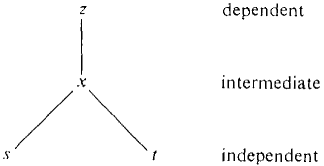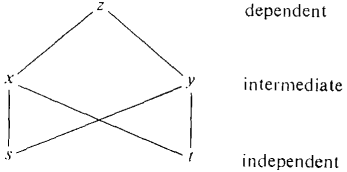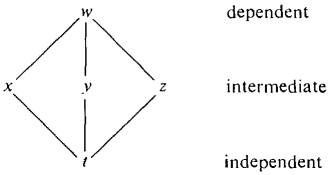| The ebook Elementary Calculus is based on material originally written by H.J. Keisler. For more information please read the copyright pages. |

|

Home  Partial Differentiation Partial Differentiation  Chain Rule Chain Rule  Chain Rules for Two or More Independent Variables Chain Rules for Two or More Independent Variables |
|||||||






|
|||||||
Chain Rules for Two or More Independent Variables
There is a Chain Rule for any number of independent and intermediate variables. We state the simplest cases here. The Chain Rules for two or more independent variables follow from the Chain Rules for one independent variable. If z depends on x and x depends on s and t, we have the diagram in Figure 11.5.3.
Figure 11.5.3 The Chain Rule for this case is: If z is a differentiable function of x and x is a smooth function of s and t, then
This follows from the ordinary Chain Rule in Chapter 2 by holding s or t constant. If z depends on x and y while x and y depend on s and t, we have the diagram in Figure 11.5.4.
Figure 11.5.4 The Chain Rule for this case is: If z is a smooth function of x and y while x and y are smooth functions of s and t, then
The Chain Rule for three intermediate variables is proved like the Chain Rule for two intermediate variables. We have the diagram in Figure 11.5.5.
Figure 11.5.5 If w is a smooth function of x, y, and z, which are in turn differentiate functions of t, then
|
|||||||
Home  Partial Differentiation Partial Differentiation  Chain Rule Chain Rule  Chain Rules for Two or More Independent Variables Chain Rules for Two or More Independent Variables |
|||||||
Last Update: 2006-11-05








